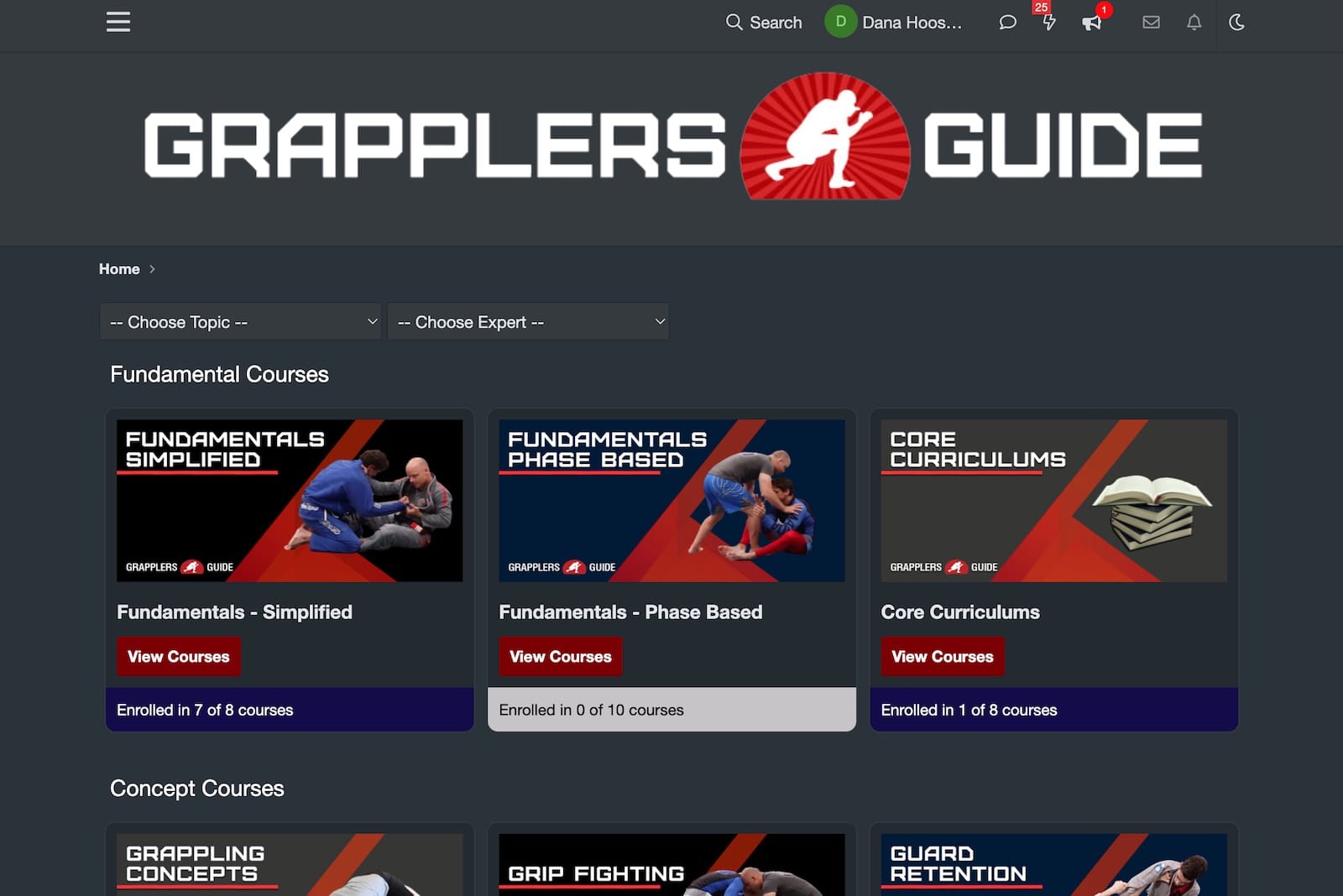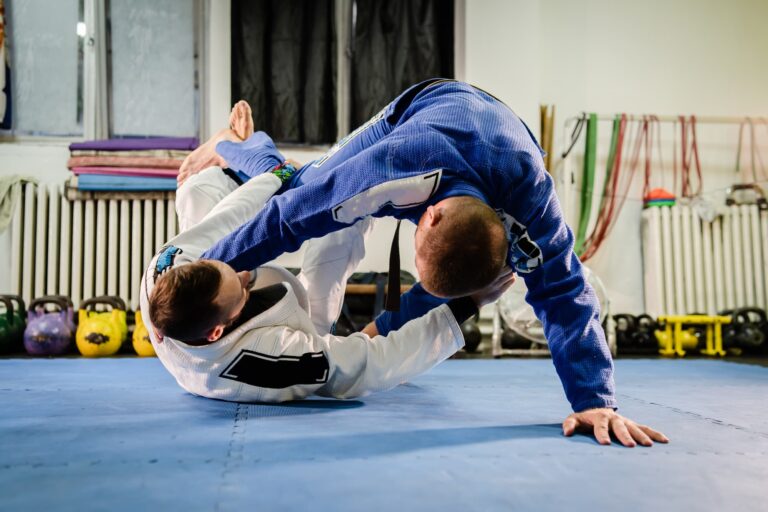Extensive Review of The Grappler’s Guide + How to Use It
The Grapplers Guide is an extensive repository of videos on Brazilian Jiu-Jitsu techniques, categorised in all kinds of ways.
If you’re a Brazilian Jiu-Jitsu (BJJ) aficionado, then you probably have been shopping around for books, courses, and “instructionals” on how to improve your game. Grapplers Guide is one of the more well-recommended resources.
But it’s kind of expensive without getting to try it out!
Before putting down money or so on Grappler’s Guide, a repository of BJJ how-to videos, I found it difficult to find exactly what was so good about it.
All I could find were ebullient posts on Reddit saying things like it’s worth much more than the full price of $299 and that I shouldn’t wait for a discount. Luckily, when I went to buy it, it was discounted in a pre-Black Friday sale, something its owner said he would never do again! Though they’re happening more and more often.
Update in late 2023: Grappler’s Guide seems now permanently discounted to $97.
But I still didn’t know:
- Who made Grapplers Guide?
- What’s so good about Grappler’s Guide?
- Is it good for beginners like me? (I had only maybe 30-50 hours experience when I first got it)
- Is Grapplers Guide really better than just looking things up on YouTube?
- How should you use Grappler’s Guide? (balancing it with mat time)
I’ve been using The Grappler’s Guide for around three months. I’ve looked at probably a hundred videos and taken notes
OK, let’s look into it.
Note: I don’t receive a commission for this review (but hey, feel free to buy me a coffee!)
You might also like my review of Lachlan Giles’ Submeta, plus a comparison between Submeta and Grappler’s Guide.
What’s The Grappler’s Guide, and Why is it So Good?
In a nutshell: Grappler’s Guide is a series of not just videos, but detailed courses on Brazilian Jiu Jitsu and associated disciplines (a bit of Judo, a bit of wrestling, and even a bit of yoga!).
You pay one time and you have access for life… or until it goes down or the Internet dies. But it has been around for over a decade already and has improved during its lifetime.
Grapplers Guide is organised, but in a not too intuitive way. So if you’re browsing through it you might think “is that it?” and feel like you’re missing entire sections.
That’s in part because the repository has grown over time. It means that the best way to use it is semi-Socratically, as I like to learn things anyway (more on that later).
Basically, if you think you might need to improve a Jiu-Jitsu concept like guard passing or takedowns, or you need to learn a specific skill like how to attack a turtle guard, then in Grappler’s Guide you’ll find not just one video on the topic, but often a long series of videos on every topic you can think of (well, every topic I can think of).
For example, we did a drill based on the X-guard in one class. I failed to pass it and kept getting subbed (white belt life). I thought “X-guard, what’s that?”. I did ask some questions in class, but later when I got home, I looked it up.
Inside Grappler’s Guide, I found a section called “X-Guard passing” with 12 separate videos, both conceptual and tactical, going over different passes in detail.
In other words, it wasn’t just a section on X-guard. It was a section with many videos just on passing the X-guard. There are other sections on submissions, sweeps, and so on.
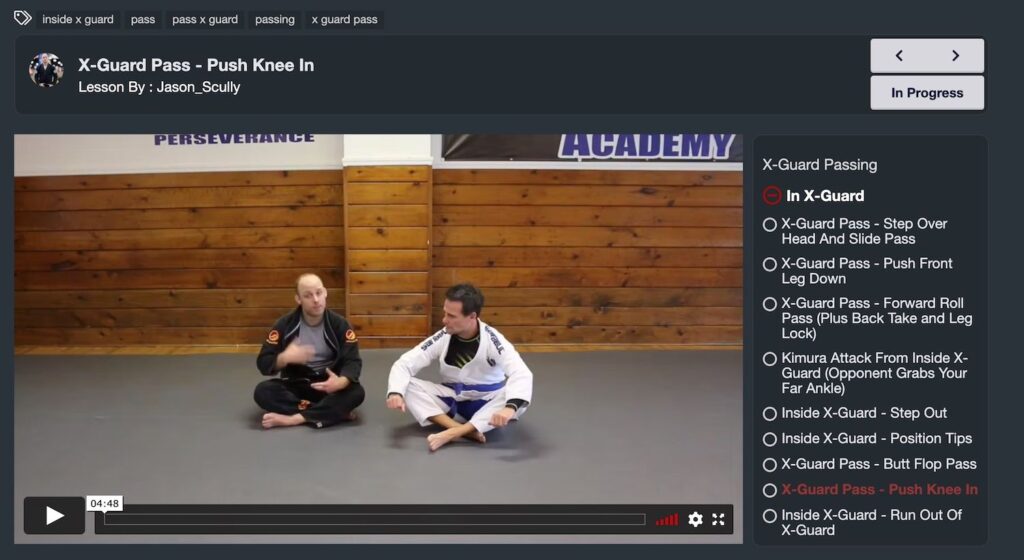
I do like to think conceptually, and Grappler’s Guide does this. They’ll give general bits of advice like “your overall goal is to get to xyz”. And even if they don’t, after watching just a few videos on a subject, you can usually figure it out.
In each section there are subsections and many videos. Each video is typically 5-10 minutes long — though shorter, sometimes, if it’s by one of the guest authors.
In that time, Jason Scully (the author of most of the videos) goes into detail about moving around in the position. He’s a really good communicator — I’d love to be instructed by him live one day (maybe in 10 years after I’ve seen every one of his videos!)
Jason also emphasises that his sparring partners aren’t just being floppy and submissive. He asks them to actually try to escape and defend to show that a technique does work in practise.
The only caveat is sometimes he’ll give them a bit of space so he’s not actually choking out his poor video demonstration partner. This is a situation in which it’s more useful to watch a live roll, something Kit Dale recommends.
Who Made Grappler’s Guide?
The Grappler’s Guide is originally the brainchild of Jason Scully, a BJJ black belt and instructor — though in earlier videos (before 2010) I’ve seen him as a brown belt. At time of writing (2023) he’s a 3rd degree black belt.
Jason has been doing these videos for decades — and it shows, some of the earlier ones are kind of sketchy video quality by today’s (and his own later) standards — though many old ones have been updated (with more up-to-date quality and also information).
While Jason’s the one who made the site and the lion’s share of the content, there are entire courses by other people — BJJ experts from around the world.
For example, my Australian compatriot Craig Jones has a whole section on leg locks, something for which he’s famous. He travels around doing guest lectures on the subject.
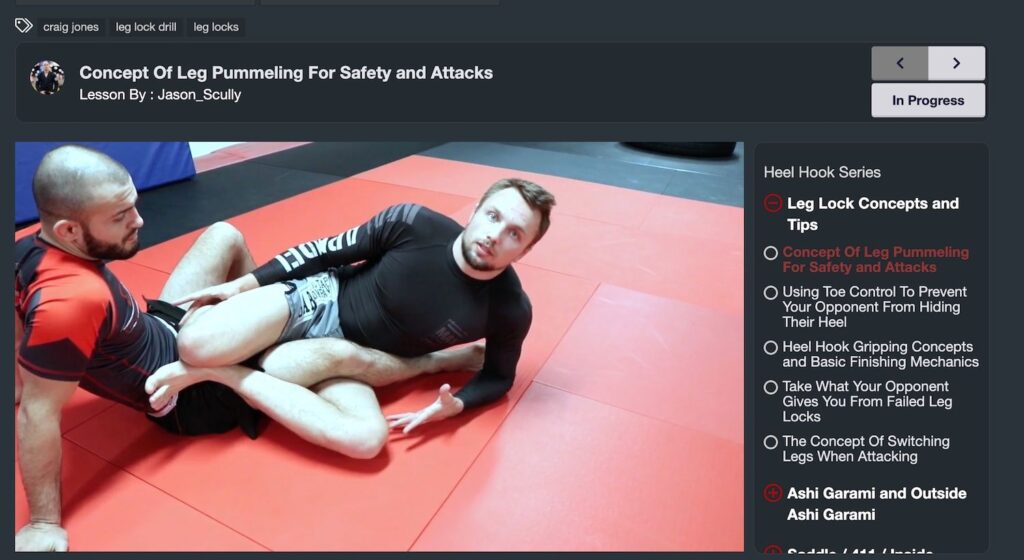
There’s a section by Lachlan Giles on sweep prevention, a series by Emily Kwok on Lapel Single Leg X, and many more.
Here’s a screen grab of all the current experts. New content is added every now and then (every 2-3 months, from recent history).

Without knowing him, but after watching many hours of his videos Jason seems like not just a good coach, but a good person! I’ve got his new gym, Revel Jiu Jitsu, in my sights as a place I’d love to spend a month or two one day (if I can afford to stay in the area).
Many high-level Jiu-Jitsu practitioners aren’t necessarily good coaches. Teaching is much harder than practicing. A good corollary is that just because someone is fluent in a language doesn’t at all mean that they can teach it.
But Jason has a very good instructional style in BJJ. He is good at articulating exactly which arm to use, how to shift your balance, and what to avoid doing. He does all this while being in good position the whole time because he’s still young and flexible.
Jason also has a very informal style which I personally appreciate. Having escaped a very traditional upbringing, I’ve come to be suspicious of clinging to traditions. Jason is gentle and mild-mannered, but he doesn’t over do it with bows or saying “oss” a lot. In fact, he ends his videos with “Peace!” It’s why I am comfortable calling him Jason rather than “Professor” (though I might call him “coach” in a class).
I don’t even know if anyone has mentioned this before, but Jason, if you read this one day: I love the informal style. Peace!
Is Grappler’s Guide Good for Beginners?
This is a question I had. I’m confident it’s good for beginners like me (an intermediate white belt when I first wrote this review). I’m also confident it’s going to be useful at least all the way through blue belt, through which I’m roughly mid-way as I update this. Beyond that — I am not so sure, but we’ll see!
The reason it’s useful for me as a relative junior is that it lets me go find out details for myself that I simply don’t have time for during a class, drilling, or rolls.
In every class, I’ll ask a teacher or sparring partner at least one thing. But sometimes they don’t know how to explain it well, or don’t want to because they’d rather focus on their own things, or there’s no time. Sometimes I don’t know the person well in general.
So I use Grappler’s Guide as my own personal tutor. For example, last night I was struggling to get an arm bar cleanly in S mount. I remember my coach Shawn had shown me once, and I had gotten it to work a couple of times, but not very cleanly. And I can’t ask Shawn again now as I’m in another country. Besides, even if I were still at SASSOM MMA in Brisbane, I’d rather use my time with him more effectively with new questions!
So I came home, looked up “S mount armbar” in search, and got a video showing the near exact same technique.
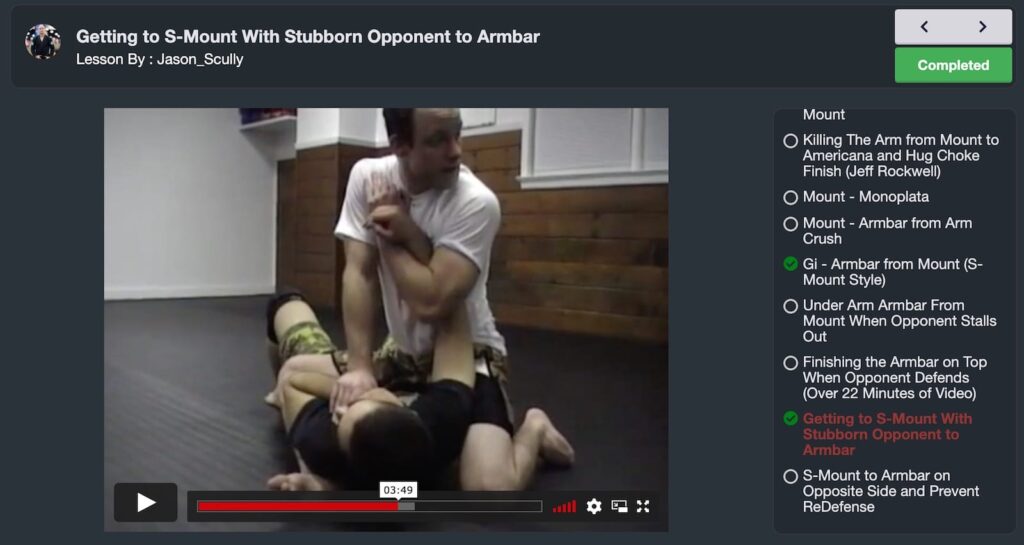
On top of that, there are a bunch of other attacks from mount, including variations on armbars from mount, chokes, and lots more.
Because it’s an online video, I can watch it multiple times, as many as I want. I can practise it, come back to refine details, ask questions in the comments section, and practise more.
This is useful even years after starting training. I might see something in a competition I want to more know details about, or I might want insight into something that my coach doesn’t feel like an expert in. Jason isn’t an expert in everything, either (it’s impossible to be), but more viewpoints build up to a comprehensive perspective.
Is Grappler’s Guide better than YouTube?
YouTube is the home of the DIYer these days. In fact, there are websites out there that are just repositories of Brazilian Jiu-Jitsu YouTube videos.
You can definitely learn things from YouTube. It depends a lot on your level, the subject matter, and the tutor.
But YouTube isn’t for everyone. People making content on YouTube have a slightly different objective. They want clicks and views to earn ad money or reputation for their gym. Yes, the information can be very informative… but if you make a “boring” video on YouTube — maybe a little lower on video quality, without flashy colours and music, and without a title that’ll get attention (with numbers, keywords, and trigger words like “The ONLY 3 submissions you need to know!”), it won’t do as well.
As YouTube video producers get better at making videos, they often start taking their content offline and putting it onto another site where they can sell it for a lot more. The result is that the content on YouTube is often just basic — an introduction. So YouTube is really OK for white belts before about 3 months, but after that it gets harder to extract much value out of it.
Grapplers Guide videos aren’t always scintillating. You’d never watch them for fun like you would a TV show or a comedy sketch. They’re more like brief lectures. In fact, I even take notes, and I expect many others do, too. It’s a lot like the demo part in the beginning of a class, in fact.
Because the videos are trying to be more informative than captivatingly produced, I love the videos on Grapplers guide. I learn a lot each time.
Also, as I get to know the author Jason via his instructional style, I learn from his other videos more easily as I see his style adapted to different situations.
The other thing I prefer about Grapplers Guide to YouTube is that every time I search for something, I get a whole section, and I can quickly go down a rabbit hole of details.
On YouTube on the other hand, I may see another video or two of questionable quality teaching the exact same thing, and then also a bunch of clickbait-y videos like “50 submissions in 30 seconds!” or whatever — fun to watch, but not useful to learn from.
One area where YouTube is great is for watching live rolls, like competitions. If you watch a long roll between two pros, you can learn a lot about how things are done in high-pressure situations when both players are tired and sweaty. The more you get to know one player’s style, the more you can learn from those situations.
How Should You Use Grappler’s Guide?
In a nutshell, here’s what I think. This isn’t just my opinion — most people around would agree with this.
Firstly, don’t just watch videos and think you’re doing BJJ. I mean, it’s fun to watch over breakfast, but you will probably need to re-watch it.
Here’s my proposal for how to use Grappler’s Guide.
- Use the “Socratic” method. As you roll in class, think about the things you’re struggling with, and then find the videos and courses in GG that might help you. Find the videos and watch them.
- As you’re watching videos, put yourself in the positions you see, even if just subtly. Even better if you have a sparring partner with whom you can practise. Sometimes I think I’ve got something, and then when I do it, I realise “oh dang, where does this other arm go?”
- If you can’t move while watching the video, visualise exactly where the limbs go if you’re sparring with someone. Imagine them escaping.
- Take notes if that helps you.
- Practise in drills and then in live rolls
- Come back and find the gaps in your knowledge.
I also find it helps never to learn more than a few things at a time from Grappler’s Guide before trying them in class. Otherwise, it’s too much info, and I get overwhelmed.
Of course, not every move will work for everyone. We all have different sized limbs, or opponents, or physical ability. But the focus should be on putting the knowledge to practise in low and then medium pressure scenarios.
So I’d say that Grapplers Guide works best if you have a lot of mat time to go around it. It’s by no means a substitute for mat time!
Alternatives to the Grappler’s Guide
The main thing people compare Grappler’s Guide to is buying many instructional videos from BJJ Fanatics.
The instructional videos on there are often very high quality. But to build up a well-rounded library you’d have to spend thousands of dollars. And then, your videos would not be as easy to search as they are on Grappler’s Guide.
There’s one alternative to the Grappler’s Guide that I think is worth mentioning, and it’s Submeta, by Lachlan Giles.
Submeta is a much more modern video platform on which Giles is codifying everything he knows, plus inviting others to submit content.
The main advantage of Submeta is the structure — the site is beautifully structured and easy to navigate. If you’re looking to learn everything about a position or submission, I find the instructional style and structure to be very easy to parse and absorb.
The main downside of Submeta, at this stage, is that a) it costs $25 a month (so six months of usage will cost the same as the discount price many get Grappler’s Guide for — for life), and b) the content on there is, while very well-structured, much less complete than on GG. There are significant sections missing. So, as much as I love Lachlan’s teaching style, Submeta doesn’t yet seem “finished” by a long shot.
Now, if he could properly partner with Jason and get all the content on there in the same structured way… we’d have a party. I wonder if that’d be possible, ever.
See more on my Submeta review here.
Sum up — Should you get it?
I’d say that in terms of money spent, Grapplers Guide is the best money you can spend. This is especially true with its discount to $97.
There are instructional courses on some other big sites that cost over $100 apiece and are just deep dives by one tutor on one subject. Grapplers Guide just gives you so much more for only a bit more money. And you get lifetime access!
There are a few good and affordable Brazilian Jiu-Jitsu books, and I’ve enjoyed some of them. But it’s hard to pick out the movement at times.
Grapplers Guide has so much content in there that it’ll take me 5-10 years to get through it all. By that time I think I’ll have spent more time with Jason Scully as a teacher than anyone else in the world! I’ll have to meet him one day… if I ever go to New Jersey.
After around six months of using it, I don’t regret getting Grapplers Guide, and I don’t think I will.

